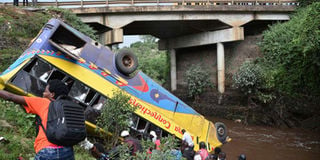The devil is in the detail: Why agencies differ on accident numbers

Nineteen people died on Tuesday, April 10, 2018 after a bus they were travelling in plunged into Siyiabei River on Narok-Mai Mahiu highway. PHOTO | GEORGE SAYAGIE | NATION MEDIA GROUP
What you need to know:
Different totals for the number of people dying each year on Kenya’s roads are reported by the National Transport and Safety Authority and the Health ministry.
- The national transport authority put it at 2,965 for 2016, while the official statistics agency had it as 4,809 people.
- Then there’s the World Health Organisation which says between 3,000 and 13,000 people die each year on Kenya’s roads.
Different sources put the road death toll in Kenya at between 3,000 and 13,000 lives lost per year. Why does it vary so much and which is the most accurate figure?
The answer to just how many people die on the road depends on who you ask.
The national transport authority put it at 2,965 for 2016, while the official statistics agency had it as 4,809 people. Then there’s the World Health Organisation (WHO), which says between 3,000 and 13,000 people die each year on Kenya’s roads.
Different totals for the number of people dying each year on Kenya’s roads are reported by the National Transport and Safety Authority (NTSA) and the Health ministry.
UNDERREPORTING
What explains the variation and which one is the closest to right?
NTSA told Africa Check they only report police data. However, underreporting is a concern as the police need to follow up on injured people, the authority’s Nairobi manager for strategies, Mr Samuel Musumba, said.
Police spokesman Charles Owino said officers are supposed to update their reports. “If a person dies while being treated, we do a follow-up report. We add the death to our list of fatalities until all the injured persons are discharged and we know there are no more fatalities,” said Mr Owino.
He added: “I believe that it is done well, unless a question arises, for example, due to differences with registration figures. In such cases, we would go back and investigate the particular police station.”
The Health ministry has a civil registration and vital statistics unit that collects data on births and deaths. This information is then shared with the official data agency.
POLICE BIAS
But inaccurate records are a major headache, said the head of the unit, Mr Samuel Cheburet.
“A person is involved in an accident and is admitted to hospital where a file is created for them. The patient can develop other complications which the hospital can manage, so the records say a ruptured spleen was the cause of death, but they are not telling us it was an accident that gave rise to that,” said Mr Cheburet.
WHO’s death toll of between 3,000 and 13,000 is not supposed to be a range, but two separate sources of data, Dr Margie Peden said. She is an associate at the Bloomberg School of Public Health at Johns Hopkins University and until recently coordinated the unintentional injury prevention section at WHO.
The number of “approximately 3,000” comes from the data on road traffic deaths that the Kenyan government supplies to WHO based on police records.
CULTURAL REASONS
But WHO also uses death certificate data, but Peden noted it is “not as well covered as we would like it to be”.
Fewer than half of all deaths in Kenya were registered between 2012 and 2016.
“We know that most countries around the world have an issue with underreporting, ranging from a small percentage in high-income countries to 50-70 per cent in some low and middle-income countries,” she said.
“Very often when you look at police data there is an urban bias, so that deaths are reported in the urban areas but in the deep rural areas that reporting doesn’t happen to the same degree. There are sometimes political and cultural reasons why deaths are not reported to the police,” she added.
STATISTICAL MODEL
Therefore, WHO applies a statistical model to the Health ministry’s data. It takes into account 12 variables “that are known to be predictive of road deaths”, such as road density, speed limits and alcohol consumption.
By this calculation, WHO’s best estimate is that 12,891 people died on Kenya’s roads in 2013, with the organisation 95 per cent sure that the total lies between 10,809 and 14,974 people during that year.
If police data is the only source relied on to compute the death rate per 100,000 people in Kenya, the country’s roads would rank as some of the safest in the world, Dr Peden added. “I don’t believe that’s a possibility,” she said.
Africa Check calculated the 2013 death rate at 7.7 per 100,000 people based on police data and the statistics agency’s population estimate for that year. This rate places Kenya in the company of countries like Hungary and Estonia.
HELMETS
But WHO estimated Kenya’s death rate at 29.1 per 100,000 people for 2013, which landed Kenya in the 20 worst countries worldwide for road deaths.
NTSA said they are seeking to increase the accuracy of their data. “We are trying to improve on our data so we do not only rely on the police,” Mr Musumba said. “We want to have an agreement with the Health ministry so that we can share more information.”
Until road death data better reflects the reality, commentators must keep the current uncertainty in mind.
From observing 256,851 motorcycle users between August 2010 and December 2014, researchers found that fewer than 40 per cent of motorcycle drivers in Thika and Naivasha wore helmets. Among passengers, it dropped to a paltry 2.8 per cent in Thika and 2.4 per cent in Naivasha.
This piece was originally published on Africa Check.





